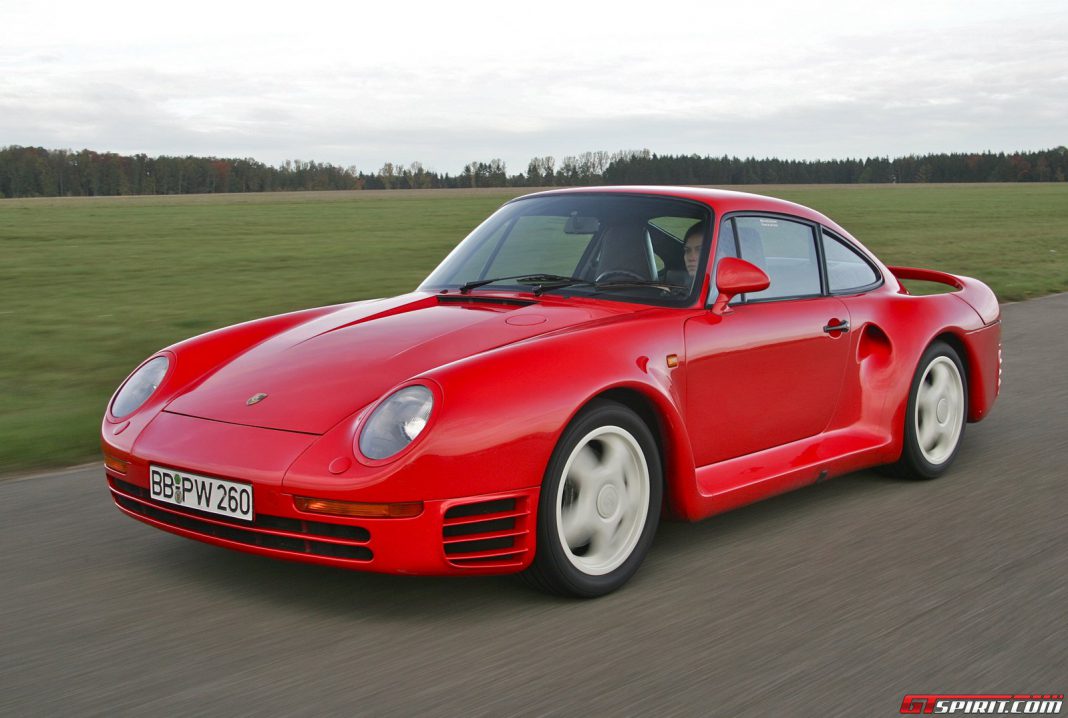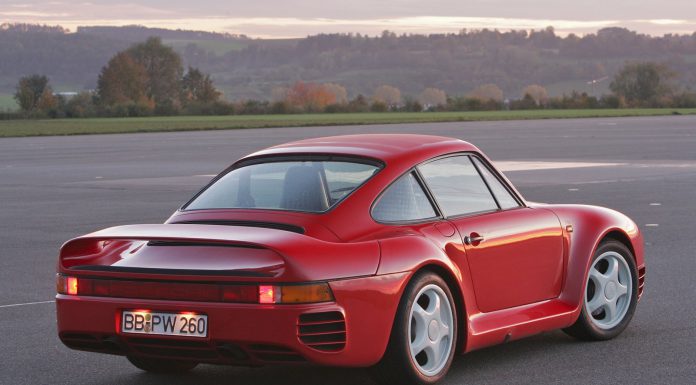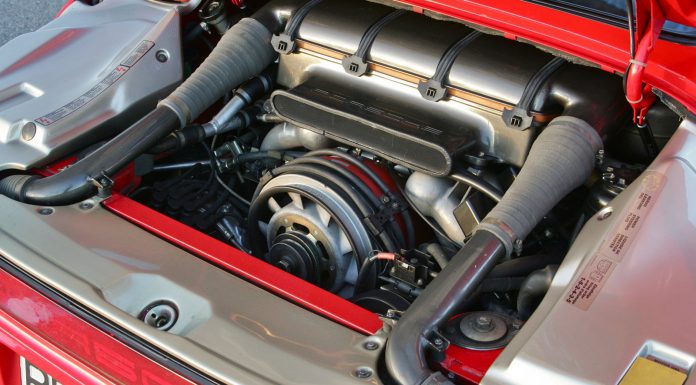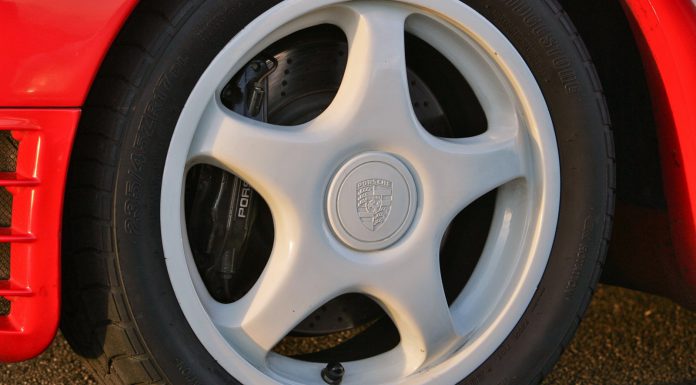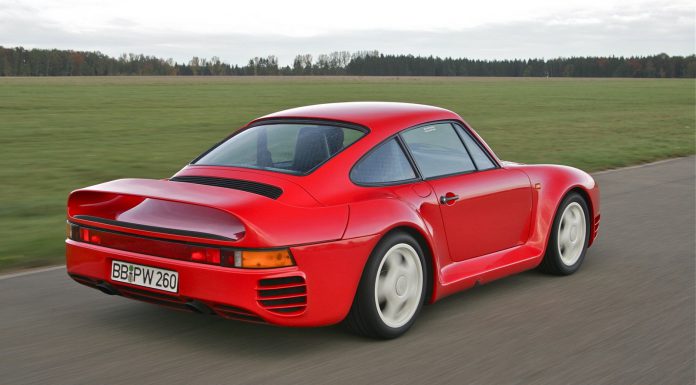No production Porsche of the 20th Century showcases innovation as readily as the 959. This was the very first production 4WD Porsche, and pioneered a lot of the technology that would later find its way into the 964 Carrera 4, the 993 Turbo and further evolve through the 4WD 996 models into the 997 Carrera 4 and Turbo we have today.
A more spectacular technical tour de force in its heyday than the contemporary Ferrari 288 GTO, the Porsche 959 still fascinates today. Made in the era before carbon-fibre came on the scene, it still used some pioneering construction materials.
While its inner structure was essentially the hot-dip galvanised steel shell from the 911, the front wings, sills, roof and entire rear bodywork was made from Aramid Kevlar and fibre-glass reinforced epoxy resin, with the door and bonnet skins pressed from aluminium. The front bumper was moulded from PU-RRIM, a material Porsche first used on the 928.
Compared to the 911, a huge amount of work was done on the aerodynamics and features like a flat-bottom helped towards the 0.31 drag coefficient. This was a great achievement in an era when supercar aerodynamics were disgraced by the 0.3 Cd of family saloons like the Audi 100 and Mercedes E-Class.
While twin-turbocharging makes a huge amount of sense for any motor with two cylinder banks, all forced-aspirated showroom Porsches up to this time had been endowed with just one KKK K26 turbo.
The 959 broke that mould by not only being the first Porsche to use two turbochargers, but also having them arranged in a sequential layout with the left-hand unit building up boost below 4,000rpm.
An intricate system of cut-in and relief valves was devised to use the boost from the first turbo to simultaneously accelerate its counterpart on the other side of the engine up to speed, so that by 4,200rpm, each turbo was responsible for a 50 percent share of the charge air pressure. Full boost of 0.9 bar was achieved by 5,500rpm.
The basic motor was closer to a competition engine than the 3.3 litre engine in the 911 Turbo. With DOHC and four-valves-per-cylinder, this 2.85 litre flat-six was unique to the 959 and where the most potent contemporary 911 had 330bhp in Turbo LE form, the 959 was good for 450bhp at 6,500rpm with 500Nm of torque at 5,500rpm on an 8.3:1 compression ratio.
The 4WD system of the 959 was the first electronically controlled variable system to be fitted to a production Porsche. It could adapt to different road surface conditions or the driver’s wishes through selected programs optimised for different scenarios like traction, rain, snow or just high performance driving on dry roads.
In steady state cruising on a dry road, the torque split is 40/60 front/rear, with 50/50 distribution on a slippery road. Under hard acceleration, 80 percent of the power and torque goes to the rear wheels making full use of the rear-engined 959s traction advantage.
With this optimum grip off the line, Porsche quoted a 0-100km/h time of 3.9 sec, 0-200km/h in 14.3 sec and a top speed of 315km/h or 197mph. These were spectacular numbers at the time, and in the famous top speed shootout organised by Auto Motor & Sport and Road & Track in 1988, and won by the Ruf CTR, the factory’s top speed claim for the 959 Sport proved right on the money.
Other technical features of the 959 were four-channel ABS, an active tyre-pressure monitoring system, speed dependent adjustable dampers and ride-height control on the Comfort version.
Today, the 959 looks small, stubby and rather ungainly next to its lower, wider and more pointy younger compatriots. Yet its relatively diminutive size is a reminder of just how big and unwieldy modern supercars have become, at least as far as everyday use on real world European roads goes.
In the quest for more speed and downforce, wide track stability and the space to make flat bottom technology and crash modules work, the contemporary supercar has become much longer and wider.
If you have owned a 911 from this period, you will feel right at home in the 959’s compact cabin. It is just as large as any sportscar needs to be in relation to the cars exterior dimensions.
The first 959 I ever drove back in 1989 was the 1,450kg Comfort version, and I recall that its three-colour leather seats were incredibly comfortable. Other than that, the main technical differences between the two version were that the Comfort had air-conditioning, rear seats, central locking, suspension with softer settings and ride height control, which gave the driver the ability to raise ground clearance from 120 to 150 or 180mm to clear ramps or other low obstacles
The Porsche Museum’s red example is one of the 100kg lighter Sport versions, and while you could also cloth or leather upholstery in either, its cloth seats do not feel as supportive even though they too are based on the same sport seats from this period.
One thing from this era that used to annoy and still does is the period aftermarket alarm/immobiliser system. As the 959 had been sitting for a few minutes, I had to withdraw the key from the ignition, lock and unlock the car and re-insert the key before I could fire up the motor. That done, the twin-turbocharged flat-six burst eagerly into life, the distinctive whirr of its 450 horses waking up, signalling that it is ready to canter.
The gearbox action feels just like the five-speed G50 box in a late 3.2 Carrera, with a short and positive shift quality. However, the 959’s six-speeder has a dogleg pattern with first to the left and down and the clutch is heavier than the Carrera, as it needs to be to absorb the extra torque.
A slow lap of the Malmsheim test tracks perimeter to warm things up and get used to the controls and their reaction on the car brings the memories flooding back. This car is so 1980s 911 that at a moderate pace, apart from the 4WD mode selection controls in the unique centre console, you would not know you were not driving a 911 Turbo. Until you push the throttle to the floor.
Even though the 2.85 litre flat-six has the advantage of sequential turbocharging, it is still not as instant as current twin-turbo Porsches. Typical of turbocharged cars from this era, the low-end response is initially rather sleepy.
The horses are wide awake but they do not all snap to attention at once. Instead they trickle in progressively until past 4,000rpm they suddenly decide that it is time to go. Then an unrelenting thrust pushes the 959 towards the horizon with real determination until it is time to grab the next ratio.
450bhp was a lot in 1988. It is not a lot in 2006. With four-door saloons from the likes of BMW and Mercedes churning out over 500bhp, and with 480bhp on tap in the 997 Turbo, the 959’s rate of departure feels brisk but not overwhelming by today’s standards. Its soundtrack is very similar to a 1980s 911 Turbo so no surprises here.
Turned into a bend at speed, the 959 Sport understeers noticeably less than the Comfort. In fact, in the mid-1990s, I witnessed one of the driftmeisters from Auto Motor & Sport Magazine getting this very car pretty sideways in a long and spectacular drift through the Stadium section at Hockenheim.
The power-steering is medium-weighted and you can feel its resistance increase as you push the car deeper into a turn. Committed to a bend, the 959 moves around a lot more on its suspension than a modern Porsche and is more affected by weight transfer. But keep it smooth and you will clearly feel the obvious transition period when you drive through the understeer and then move the tail out into power oversteer.
In its time, the 959 was a massively complex car in terms of its early generation electronics and hydraulics. Cars of that era showcased the first generation of driver support systems that are run-of-the-mill today. Unfortunately, this means that their reliability cannot be taken for granted, and it is a well-known fact that driving a 959 regularly is far better for it and can result in lower maintenance bills.
However, viewed in context, the 959 is a landmark car and will always be able to hold its head up high in the company of the more flamboyant but relatively fragile Italian supercars from this era.

